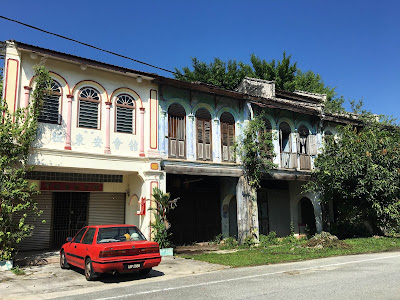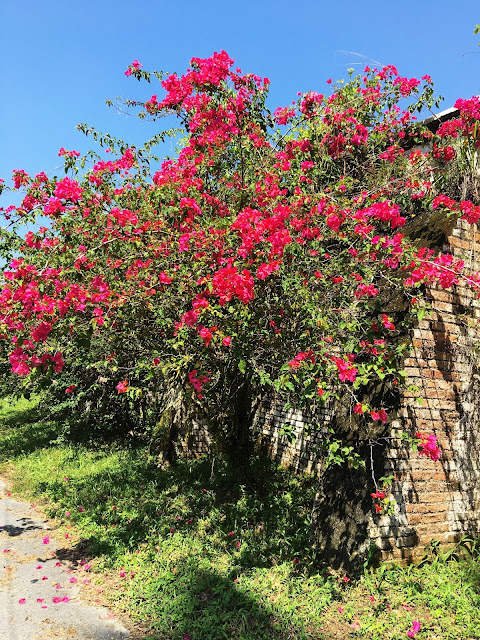I read "No Dram of Mercy" many years ago. It records the heroism of a woman by the name of Sybil Kathigasu who suffered extreme physical and mental torture at the hands of the Japanese Army "Kempetai" but detemined to help wounded members of the Malayan People's Anti-Japanese Army (MPAJA) in Papan, Perak. The Japanese invaders, after ousting British in 1941, occupied Malaya and ruled with fear and terror.
Sybil was a trained nurse, a respected midwife, an educated middle class French and Penang Eurasian descent, married to a Dr Kathigasu, transformed her house in Papan into a secret hospital for injured MPAJA guerillas who were fighting the Japanese. They were betrayed and caught in 1943. Sybil was tortured mercilessly, for 3 years. Even after being burnt, kicked, beaten, and her 5 year old daughter dangled from a tree with a threat to roast her alive, Sybil refused to divulge any information about the resistance movement. She survived her ordeal but her health was severely affected.
She was awarded the George Medal for gallantry at the Buckingham Palace by King George VI. The one and only Malayan woman who have ever received this medal of courage. Sybil died in 1948 in Scotland.
When I first read the book, I wondered why Sybil wasn't in our history books. Malaya must have many unsung heroes just like Sybil. Wished they were all made known to us, at least to us who are interested. Well, I finally get a chance to drive to Papan to see for myself, Sybil's clinic. It is in poor shape but it is all still there.
These news clippings were just pasted on the front door.
The front entrance
No 74 Main Road - Sybil's clinic in Papan
Papan is a ghost town, so as many said. I drove into Papan and it was kinda eerie. Upon entry, on my right was a huge Chinese temple and cemetery. Then I saw 2 rows of shop houses, one row on the left and one row on the right. That's it? That's Papan?
As I drove along Main Road in search of Number 74, I noticed there were only TWO coffee shops. Both had people sitting around tables, chatting at the top of their voices. I actually had a 100 Plus in one of the coffee shops. Housewives were having their morning meet in the same shop, chatting away about their kids.
The shop houses, as you can see, were so rotten. It is difficult to see which were occupied and which were not. How could anyone live in these? How do they get their groceries? Daily food?
Plastic chairs under the trees; that's how they chat their time away I guessed.
Imagine this is your neighbour!!!!!!!!!!!!!!
I was flabbergasted at the above residence. There were 2 beautiful dogs barking at me in the ground floor. Look at the top floor! So you live downstairs and let upstairs rot???
The town hall
There was a small lane in between the school and I drove in to search for Istana Billah @ Billah Palace or better known as the Mandailing Mansion which was built in 1896. Raja Billah was a Mandailing aristocrat from Sumatra, who made Perak his home, died in 1911. He was the Headman of Papan.
Apparently this location was used to film Anna and the King in 1999.
The grand entrance
The grounds of the palace
The house next to the palace. Maybe a guard lives there now?
Billah Palace is actually famous for strange happenings and mysteries. The locals are convinced that this place is haunted. A local documentary on TV featured this place for paranormal activities.
Empty wooden houses located around the palace grounds
Beautiful bourgainvillas
Back lanes of Papan
Papas was established as a settlement of the Mandailing people under the leadership of Raja Billah. Papan means plank. In the 1800s, chengal wood was sawn in Papan, hence its name. Later on Papan became the richest tin mine in the Malay Peninsula. When Raja Bilah sold his mining operations, Papan lost its fame. The Japanese occupation contributed to the downfall of Papan.
Today Papan is literally in ruins. It is one of the smallest and oldest towns in Malaysia but nothing is being done to preserve anything there. Amazingly there are more birds living there than humans!
Sybil was a trained nurse, a respected midwife, an educated middle class French and Penang Eurasian descent, married to a Dr Kathigasu, transformed her house in Papan into a secret hospital for injured MPAJA guerillas who were fighting the Japanese. They were betrayed and caught in 1943. Sybil was tortured mercilessly, for 3 years. Even after being burnt, kicked, beaten, and her 5 year old daughter dangled from a tree with a threat to roast her alive, Sybil refused to divulge any information about the resistance movement. She survived her ordeal but her health was severely affected.
She was awarded the George Medal for gallantry at the Buckingham Palace by King George VI. The one and only Malayan woman who have ever received this medal of courage. Sybil died in 1948 in Scotland.
When I first read the book, I wondered why Sybil wasn't in our history books. Malaya must have many unsung heroes just like Sybil. Wished they were all made known to us, at least to us who are interested. Well, I finally get a chance to drive to Papan to see for myself, Sybil's clinic. It is in poor shape but it is all still there.
These news clippings were just pasted on the front door.
The front entrance
No 74 Main Road - Sybil's clinic in Papan
Papan is a ghost town, so as many said. I drove into Papan and it was kinda eerie. Upon entry, on my right was a huge Chinese temple and cemetery. Then I saw 2 rows of shop houses, one row on the left and one row on the right. That's it? That's Papan?
As I drove along Main Road in search of Number 74, I noticed there were only TWO coffee shops. Both had people sitting around tables, chatting at the top of their voices. I actually had a 100 Plus in one of the coffee shops. Housewives were having their morning meet in the same shop, chatting away about their kids.
The shop houses, as you can see, were so rotten. It is difficult to see which were occupied and which were not. How could anyone live in these? How do they get their groceries? Daily food?
Plastic chairs under the trees; that's how they chat their time away I guessed.
Imagine this is your neighbour!!!!!!!!!!!!!!
I was flabbergasted at the above residence. There were 2 beautiful dogs barking at me in the ground floor. Look at the top floor! So you live downstairs and let upstairs rot???
The town hall
There was a small lane in between the school and I drove in to search for Istana Billah @ Billah Palace or better known as the Mandailing Mansion which was built in 1896. Raja Billah was a Mandailing aristocrat from Sumatra, who made Perak his home, died in 1911. He was the Headman of Papan.
Apparently this location was used to film Anna and the King in 1999.
The grand entrance
The grounds of the palace
The house next to the palace. Maybe a guard lives there now?
Billah Palace is actually famous for strange happenings and mysteries. The locals are convinced that this place is haunted. A local documentary on TV featured this place for paranormal activities.
Empty wooden houses located around the palace grounds
Beautiful bourgainvillas
Back lanes of Papan
Papas was established as a settlement of the Mandailing people under the leadership of Raja Billah. Papan means plank. In the 1800s, chengal wood was sawn in Papan, hence its name. Later on Papan became the richest tin mine in the Malay Peninsula. When Raja Bilah sold his mining operations, Papan lost its fame. The Japanese occupation contributed to the downfall of Papan.
Today Papan is literally in ruins. It is one of the smallest and oldest towns in Malaysia but nothing is being done to preserve anything there. Amazingly there are more birds living there than humans!










































No comments:
Post a Comment